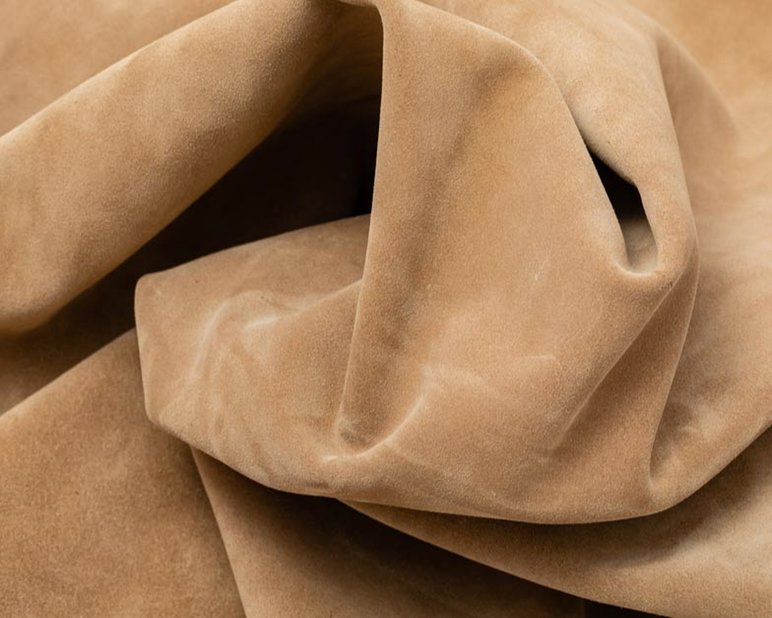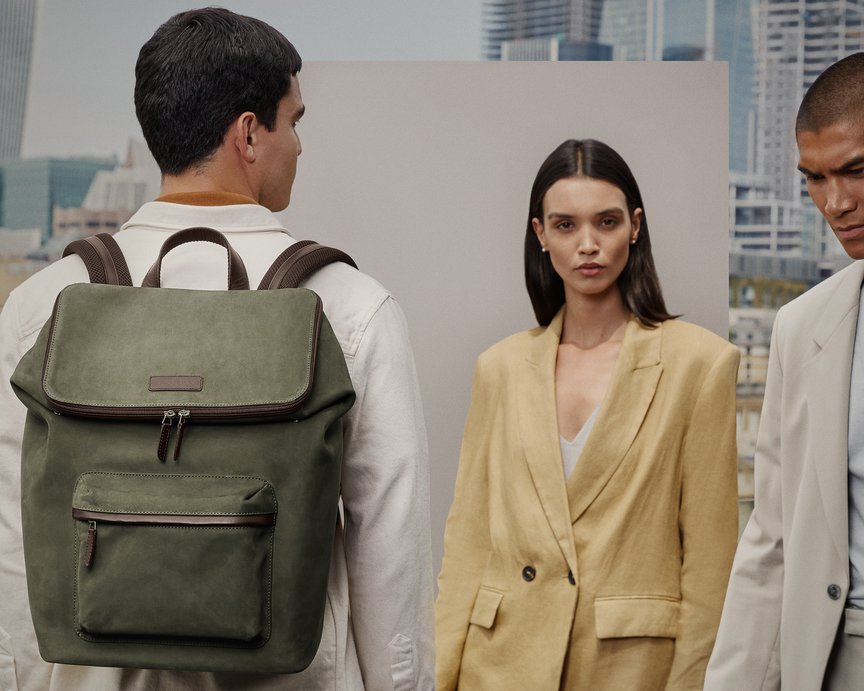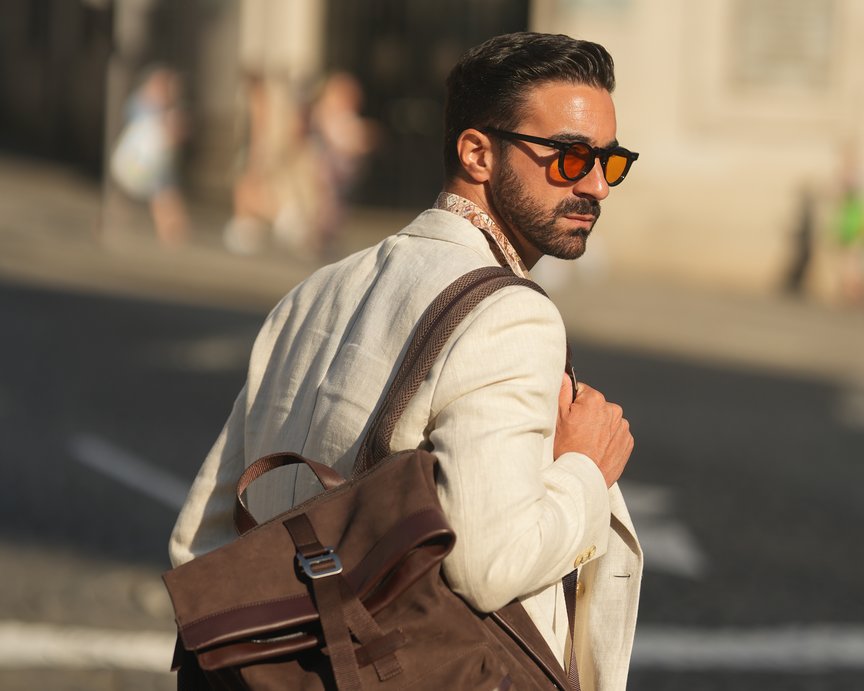Whether you’re a long-time leather lover or a budding novice, you’ve likely come across the term ‘nubuck’ before.
What is nubuck?
Published 3 years ago

This luxurious type of velvety, full-grain leather adorns everything from Timberland’s iconic boots to high-end wallets and handbags.
You already know its soft, sumptuous texture looks the part on apparel and accessories. But have you ever stopped to ponder, “What is nubuck?”.
In this post, we’re deep-diving into the finer details of this sought-after leather type. We’ll be examining its etymology, history and properties, as well as the material's key pros and cons.
What is nubuck?
In a nutshell, nubuck is a premium velvety leather type made by sanding down the outer-facing layer of an animal’s hide.
Aeons of evolution led the outer layer to develop thick, tightly-packed fibres for optimal durability and water resistance. After all, it’s the outer layer that must withstand the rigours of Mother Nature. As such, high-quality nubuck is a very durable material.

How is nubuck made?
A tannery separates the outermost layer from the hide using industrial tanning machinery. A specialised leather worker then sands the outer grain-side surface to shorten the protein fibres and create an appealing type of velvet-like napped leather.
The result? A resilient yet soft leather that is reminiscent of suede.
Once sanding is done, the tannery can dye and treat nubuck for a smooth finish. At times, tanneries forgo this step as some manufacturers prefer working with leather that has imperfections, believing it adds character to the final product.
Nubuck characteristics
The sanded and buffed protein fibres give nubuck its distinct texture. Although the finish is similar to suede, it’s not exactly the same. Nubuck’s nap is slightly more pronounced, which makes it appear a tad more rugged.
Rubbing nubuck causes the colour to change as the fibres flip over; rubbing in the opposite direction will restore the original finish.
Nubuck does darken once it gets wet. But unlike other napped leather types (we’re looking at you, suede), it will retain its original colour once dry.
Despite boasting a soft premium sheen, you can expect nubuck to be long-lasting.

What animal hide does nubuck come from?
In the old days, leatherworkers made nubuck from the hide of a male deer, moose or elk. Some etymologists suspect this explains the origin of the name: ‘new buck’.
Nowadays, however, tanners typically make the leather by sanding down the exterior of calfskin. The modern approach results in a velvety texture that feels soft to the touch.
History of nubuck
Artisans first began producing nubuck during the 19th century. Before the era of mass agriculture, hunters would slaughter wild deer, elk and moose for their meat and hides. Leatherworkers realised they could create a durable yet elegant type of velvety leather by sanding down and dying the outer layer of the hide.
Allegedly, the now-famous leather type didn’t become widely popular until the 1930s when the Duke of Windsor visited America wearing a slick new pair of nubuck shoes. The look was an instant success, and nubuck became a hit among aristocrats on both sides of the Atlantic.
These days, the luxury leather type gets worn by everyone from style-conscious blue-collar workers to jet-setting celebrities.
Uses of nubuck
Its hard-wearing properties make nubuck a top contender for leather goods designed to be used outdoors. From Timberland hiking shoes to Birkenstock sandals and Ugg boots, high-end footwear manufacturers (and consumers) can’t get enough of the stuff.
This abrasion-resistant nature also makes nubuck suitable for accessories that receive constant human contact. Common everyday examples include mobile phone covers, bags and wallets.
While it’s a bit less supple than other leather types, nubuck still works well when creating elegant apparel like gloves, jackets and skirts.
Furniture designers are increasingly turning to nubuck to achieve a plush yet durable product that can withstand the test of time. If you’ve ever seen a soft, velvety sofa that looks and feels a bit like suede, chances are it is nubuck.
Another popular nubuck product is the backpack. Contemporary consumers love the luxurious nubuck look and appreciate its inherent durability.

Carl Friedrik Rover collection
Nubuck is one of the key materials in our latest collection of everyday bags — the Rover range.
The urbane yet easy-going nature of nubuck represented a perfect fit for the Rover bags, which are designed for frequent use yet retain a luxurious feel.
Our nubuck is sourced from a high-quality tannery in Palomares, Southern Spain. Taken from the strongest part of the cow's hide, it has the necessary robustness for a lifetime's worth of journeys.
If you've been swayed by the redeeming qualities of nubuck, check out the Rover collection. From Day-to-Day Backpack to Compact Weekender, we've crafted a bag to meet the needs of every modern rover.

Benefits of nubuck
So is nubuck worth the elevated price tag? We certainly think so. Here’s why this soft luxury leather type lives up to the hype.
Aesthetic
The aristocrats of old adored their fashion-forward nubuck shoes. And even though Elvis may have been partial to suede, contemporary, fashion-forward stylists are raving about the nubuck look.
In fact, many believe nubuck looks even better than its close counterpart. As the nap in nubuck is more pronounced than suede, it emits a somewhat rugged aesthetic.
Longevity
Nubuck comes straight from the toughest part of the hide. The thick, robust outer layer can withstand a beating without wearing out, which is why it’s so prevalent in upmarket shoes and everyday accessories.
Breathability
Splitting the hide layers forces the fibre proteins to break down, which results in a porous end product. As a result, nubuck is more breathable than most synthetic materials and other leather types, making it an excellent choice for shoes.
Low maintenance
Some luxury leather types require a rigorous schedule of polishing, buffing and shining. Nubuck, on the other hand, is a cinch to maintain. An occasional brush down is all you need to keep the fabric looking dapper.

Drawbacks of nubuck
While we’re big fans of nubuck, there’s no such thing as the perfect leather. Here are a few drawbacks to consider.
No patina
Patina is a natural ageing process that occurs when a susceptible surface (for example, leather, copper, or brass) gets exposed to the elements for a prolonged period. While many leather types receive a patina in the form of a time-worn sheen, the method used to produce nubuck means it will not.
That said, it’s more of a personal preference than a hard-and-fast drawback.
Price
As they’re made from the strongest section of the hide, nubuck products cost more than other leather types. Nonetheless, many style-conscious consumers feel it’s worth paying a premium to obtain a durable, aesthetically-pleasing end product.
Scratches
Nubuck won’t scuff easily, but its distinct nappy texture makes it susceptible to scratches. While you should tread carefully, there’s no need for alarm. A small scratch or two may even enhance the rugged texture of the leather.
Stains
Unlike some luxury leather types, nubuck is somewhat susceptible to stains. Oil, grime and some liquids can leave a permanent splotch on the surface.
Takeaway
Durable, stylish and breathable, this soft velvety leather makes for quality accessories and shoes. While it does cost a touch more than other leather types, it’s well worth it — especially if you’re seeking a long-term investment.